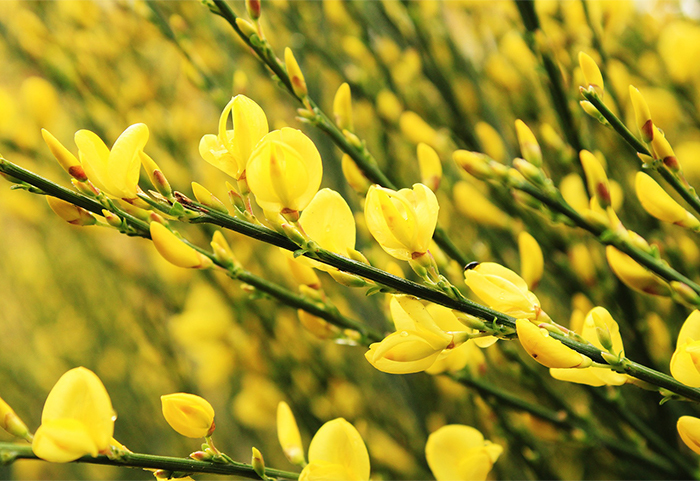Broom – local native or destructive weed?
Mary Hinsen
19 March 2021, 5:00 PM
 This local native is no weed and can make a beautiful addition to any dry garden setting.
This local native is no weed and can make a beautiful addition to any dry garden setting.Like gorse, broom is well-known as a troublesome scrub weed from the legume family – however not all broom plants are created equal.
The Cromwell broom is not always recognised as the local native we should be caring for and encouraging, as the word ‘broom’ evokes thoughts of the plant we know as a very hard to get rid of pest. But not all broom species are created equal.
Broom - the weed
What we know as broom, scotch broom, Cytisus scoparius is a problem weed. It isn’t spiny like gorse, and so it is easy to get stock to feed on it and near it. However, it can become dense just like gorse, making access to pasture difficult or impossible for stock.
Broom tolerates cold conditions well, and is considered one of the most troublesome weed species for our forestry industry – it can grow up to three metres tall in our forests.
Broom can build up very high seed densities in the soil, with research by Massey University showing densities as high as 36,000 seeds per square metre of soil in our pine forests.
The seed is very long-lived, so these sorts of densities still exist when one crop of trees is harvested, ready to germinate when the next crop is planted. The broom plants then cause severe competition for the trees during the first 10 years of their life.
Broom has pliable, ridged green stems which may have small leaves, or can be leafless. It has yellow flowers and seed pods similar to gorse.

Scotch broom is a notorious weed - and nothing like its Central Otago counterpart.
As with many scrub weeds, broom soon regrows from dormant buds on stumps if shrubs are cut off. Regrowth from buds can also occur after fires. Many herbicides are not very effective on broom because of the lack of leaves, which are needed for herbicides to be absorbed.
Landcare Research Manaaki Whenua is currently conducting a biological control programme on broom, and has so far released five insect species, each with promising results. Ecological studies suggest that biological control is likely to be able to succeed against broom in the longer term.
The Cromwell broom - a local native
The Cromwell broom Carmichaelia compacta, by comparison, is not a pest weed. It is listed as ‘At Risk’ on the New Zealand Plant Conservation Network Rōpū Hononga Koiora Taiao ki Aotearoa website.
The Cromwell broom is found only in Central Otago, centred around the Cromwell and Kawarau Gorges, and into the surrounding areas of Alexandra and Omakau.
It is a small, yellow-green shrub with many upright twigs, with no leaves. The twigs are oval in cross-section and grooved, and being leafless, this is the only area the plant has for photosynthesis.
Flowers are not bright yellow. They are small, pea-like, pink with slightly darker stripes, and found in clusters. The flowers fade to a soft, creamy yellow colour quite quickly.
The flowers have a pleasant fragrance which attracts pollinators such as our native bees.
Cromwell broom flowers from October through to February. After flowering, the small, dry, flattened pods appear, containing a single hard seed.
Cromwell broom lives on schist rock slopes, rock outcrops and in the Cromwell and Kawarau gorges.
Haehaeata Natural Heritage Trust member Rachael Baxter explains the complete absence of leaves is the way the plant successfully adapted to the Central Otago environment.
“The complete absence of leaves are an adaptation for plants that inhabit places exposed to high winds, drought and temperature extremes - which describes the habitat they are found in very well,” she says.
Rachel says grazing is the main threat to our Cromwell broom.
“All our introduced herbivores seem to really enjoy munching on them.”
Haehaeata nursery manager Dhana Pillai says the Cromwell broom is an excellent plant to consider for a dry garden.
“Being a hardy nitrogen fixer, it is excellent for any dry site. It even grows on saline soils,” she says.
“The flowers are also valuable as a food resource for insects.”
Dhana explains people haven’t generally grown it in home gardens, as it is not available from commercial garden centres.
“However, it is a very special plant that grows only in Central Otago.
“We should be doing more to promote it.”
Rachael agrees.
“I think it would be a great garden specimen with year round colour.
“It’s evergreen, has lovely flowers, a nice form and for people with a drier area and well draining soil it would go well.
“I also think it would be good for xeriscaping – a garden form that uses drought resistant plants and water conservation.”
“If people plant it in their gardens, hopefully it will also grow greater appreciation of our native flora and there will be more interest in protecting these plants in their natural habitat.”
Images supplied




